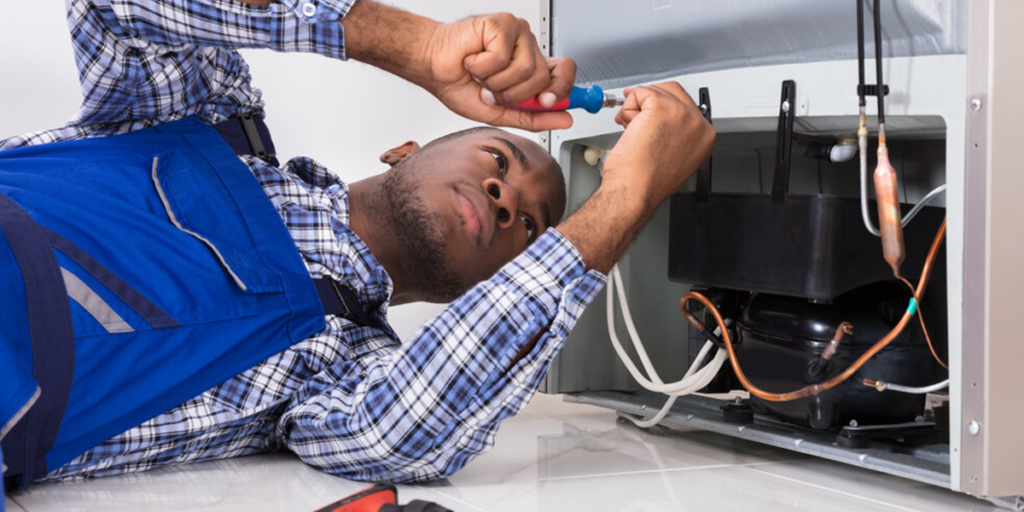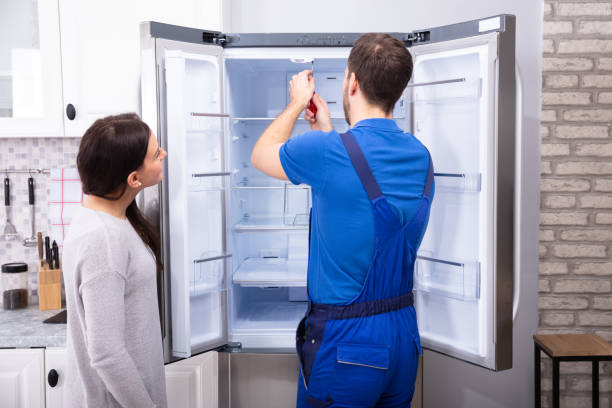
Stove Repair Service: Solving Heating and Electrical Problems
Understanding Your Appliance: Basic Stove Framework
The common oven layout contains a few vital architectural elements that maintain its capability. These are the stove dental caries, thermostat, heating element, racks, and control board. The oven tooth cavity is the central food preparation compartment, designed to expand heat equally, together with thermo-insulating residential or commercial properties. The thermostat part constantly manages heat temperature level, offering an optimal food preparation environment. The burner is the chief resource of warm-- it could be electric or gas. Racks supply assistance for the baking trays, whereas the control board comprises all user-operated controls.
Understanding these essential elements and their functions is the initial step in the direction of understanding just how an oven operates. For example, when a stove is turned on, electrical or gas energy is transformed to thermal energy by the burner under the control of the thermostat. The heat produced is after that evenly dispersed within the oven tooth cavity. This standard understanding allows individuals to recognize typical concerns such as uneven baking or temperature variation, further equipping them to execute quick and efficient troubleshooting.
Identifying Typical Home Heating Issues in Stoves
Usual heating concerns in ovens typically make themselves recognized through a variety of clear signs. These may consist of fluctuating temperatures, where the stove fails to maintain a consistent warmth, or uneven cooking, where food cooks quicker on one side than the various other. An additional clear symptom is when the oven takes longer than anticipated to get to the collection temperature or it merely gets to a temperature much less than preferred. Pre-heating must commonly take no more than about 15 minutes depending upon your home appliance. If it takes substantially longer, a heating concern might be at hand.
Ovens can also show a relentless mistake code on the oven display screen, suggesting an interior concern which could be associated with the home heating systems. They might also fail to warm in all, a guaranteed indication of a home heating problem. Some stoves might even overheat, getting much hotter than the chosen temperature level and melting the food. In worse instances, they can potentially be a fire threat. It is vital to remain observant of these common signs to identify and rectify home heating concerns at an onset.
Reliable Approaches to Troubleshoot Stove Home Heating Issues
Having actually recognized the potential issues affecting your stove's home heating capacity, it's critical to use effective troubleshooting approaches to mitigate these issues. The first step involves initial checks. Make certain the source of power is connected ideally and that the stove's thermostat is established properly. Making sure these essential factors remain in order can frequently remedy small concerns without more intensive inspection.
On the other hand, if problems linger after the preliminary checks, dive much deeper right into possible hardware breakdowns that could be the origin of the home heating problem. Start with taking a look at the burner. In instances where it appears damaged or malfunctioning-- characterized by noticeable fractures, sores, or it seems worn out, it is extremely possible this might be the root cause of the issue. An additional crucial component to evaluate is the oven sensing unit. Majority of ovens consist of a sensor that plays a critical function in keeping the required temperature level array. Because of this, a malfunctioning sensor can substantially affect the stove's heating performance. In order to evaluate the sensor's performance, you may need a multimeter-- an innovative tool made use of to measure electric homes such as resistance and voltage. It is recommended that these actions need to be performed cautiously taking into consideration the intrinsic risks associated with electric appliances.
Following this, if the oven still stops working to heat up correctly, take into consideration checking for a faulty bake or broil component. These components are responsible for providing the warmth needed to cook your food and could be adding factors if they're defective. Last but not least, evaluate other elements such as the control panel and wiring connections which can additionally influence heating performance.
To sum up, below work techniques that can assist you repair heating problems in an oven:
Accomplish initial checks: Make certain that the power source is connected properly and inspect if the thermostat setup is exact.
Inspect hardware malfunctions: If preliminary checks do not settle the issue, check out possible hardware issues. Beginning by checking out essential elements like:
The Burner: Look for noticeable splits, sores or indicators of fatigue.
The Stove Sensor: Use a multimeter to measure its electrical homes and figure out whether it's operating appropriately.
Check into various other possible concerns: If all else falls short,
Review Bake or Broil Elements: These parts supply essential food preparation warm; their malfunctioning might lead to inadequate heating.
Review Control Panel & Circuitry Links: Faulty links or a troublesome control board may also be at fault.
Keep in mind always exercise caution while dealing with electric devices because of intrinsic dangers involved. It's advised that just people familiar with taking care of such devices must attempt these fixing steps individually. In case of consistent problems despite adhering to these approaches, looking for specialist assistance would certainly be a good idea.
Delving into Electric Problems in Ovens
Recognizing the electric functioning of your oven is essential in identifying possible issues that may arise. Typically, these problems surface in the form of a stove that doesn't warmth effectively, intermittent power or in extreme cases, complete failing of the appliance. These problems may be caused by countless elements varying from faulty wires to defective burner or problematic control switches.
Circuit-related troubles are frequently discovered within the intricate web of cords and connections stashed within the stove's structure. These mistakes can typically cause short-circuiting or underperformance due to inconsistent power circulation. Furthermore, stopping working to identify and rectify these electrical problems can not just diminish a home appliance's operational effectiveness, yet also present possible fire hazards and electric shock dangers. Consequently, understanding these problems and utilizing the proper measures to address them is vital.
Practical Tips to Detect Electric Issues with Ovens
Identifying electrical problems with stoves typically begins with an extensive aesthetic examination. First and foremost, always guarantee to unplug the oven before beginning any kind of examination to remove the threat of electrical shock. After doing so, check the power cord for any visible signs of wear, tear, or burning. Then, continue to check out the incurable block located at the back of your oven-- it may be feasible that the concern emerges from a loose or scorched cord. This primary evaluation can offer useful understandings right into whether the problem is connected to the power source or internal electronic components of the oven.
In case you found no problem during your visual assessment, your following point to concentrate on must be the stove's inner components. Make use of a multimeter to examine the burner' connection, as damaged components can be an usual source of electric troubles. If the multimeter analysis continues to be unmodified, this shows an absence of electrical flow and the aspect in question may require substitute. Similarly, the oven thermostat, a variable resistance button controling the warmth, must also be tested for electrical continuity. If these tests don't generate outcomes, consider testing the stove's timer and selector switch, keeping in mind that these parts need more technical knowledge to analyze accurately.
Safety Precautions to Take Into Consideration during DIY Troubleshooting
Engaging in do it yourself troubleshooting of your stove can potentially save you a substantial quantity of expenditure on repair work, but doing it without due diligence can posture a substantial threat to personal safety and security. It's important to comprehend that engaging with home appliances, particularly those reliant on gas or power like stoves, requires a certain degree of caution and prep work. Always ensure to switch off and unplug the device prior to initiating any type of probing or disassembly. To prevent an electrocution hazard, never ever perform fixings with damp hands or stand on a damp floor.
In addition, constantly utilize the appropriate devices for any type of maintenance jobs and never ever effort to force components apart or together. This not only prevents unintended damage to the appliance yet likewise mitigates the threat of personal injury. Safety wear, such as rubber gloves and safety glasses, can supply an additional guard against unintended damage. Most importantly, if you're unclear or unpleasant with any kind of steps in the procedure, it is prudent to step back and call expert aid.
Devices Required for Stove Repair Work and Upkeep
Embarking on the job of oven repair work and upkeep demands the employment of the proper devices. Having the right tools not just guarantees a reliable and timely repair process however also substantially reduces the possibility of added damages as a result of improper handling. A few of the crucial tools consist of a multimeter, which is made Oven Circuit Issues use of to measure the voltage, resistance, and other crucial electric worths in the oven. This assists in determining precise electrical faults. A collection of screwdrivers, outlet collections, and wrenches are also essential for the taking apart and rebuilding of the oven.
In addition to these basic tools, a pair of needle-nose pliers shows to be vital for taking care of tiny things or getting to limited rooms within the stove framework. A cord stripper can likewise be available in convenient when dealing with oven's electric systems. A warmth weapon, as an example, is needed for jobs such as chilling out rigid cables or diminishing the tubing around wiring connections. Moreover, investing in high-quality shielded handwear covers is of vital value to make sure security during job, as it gives defense versus prospective shocks or burns. These tools form the essential toolkit for a person aiming to carry out oven repairs and upkeep themselves. Nonetheless, one ought to also remember that facility or high-risk issues ought to be left in the hands of a professional.
Specialist Help: When to Hire an Expert
Stove problems that are beyond standard troubleshooting may demand a specialist's intervention. When you find that the device often trips your breaker, does not warm equally or just fails ahead on, it may show an extra serious problem. Such detailed concerns could include hands-on repair work of essential parts, rewiring of interior systems or dealing with possible gas leakages-- tasks that need to not be ignored because of their potential to create damage or home damage.
Hiring a specialist is not merely concerning solving the immediate concern. It's likewise concerning making sure the longevity of your device and the security of your home. Technicians are proficient in interactively diagnosing and fixing home appliances, led by their substantial training and experience with a variety of stove models and brands. They can usually supply valuable recommendations on maintenance and preventive measures, based upon their understanding of the unit's background and condition. Trusting these jobs to a professional can stop future break downs, conserving you time, money, and potentially guarding your home from major cases triggered by wrong or incomplete repair services.
